 The market for primary electronic flight displays reached the saturation point a while ago, effectively sending spinning gyroscopes and the vacuum systems that drive them to extinction. Reliability, situational awareness and advanced autopilot interfaces only scratch the surface of benefits. So if you’re building a kit from scratch or retrofitting an aging one, your sights are likely focused on one of the many modern big-screen EFIS options. And before long, your head will be spinning with almost too many choices, combinations and features. The good news is that Garmin, Dynon, Grand Rapids and MGL have worthy options for all budgets and panel space requirements.
The market for primary electronic flight displays reached the saturation point a while ago, effectively sending spinning gyroscopes and the vacuum systems that drive them to extinction. Reliability, situational awareness and advanced autopilot interfaces only scratch the surface of benefits. So if you’re building a kit from scratch or retrofitting an aging one, your sights are likely focused on one of the many modern big-screen EFIS options. And before long, your head will be spinning with almost too many choices, combinations and features. The good news is that Garmin, Dynon, Grand Rapids and MGL have worthy options for all budgets and panel space requirements.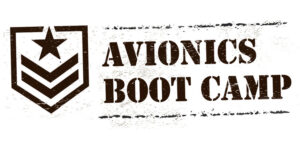
Where to begin? You might narrow the decision to all-in cost and install complexity, which could mean buying a basic system to start and adding more displays later. Maybe you plan to fly VFR for now but want to earn the instrument rating later on. That could mean adding more capability, which means more data on a single screen. Thanks to digital data buses and software, most brands and models have decent growth potential, third-party integration and the ability to add more screens later on.
To help with the buying decision and to supplement your shopping (which should include a thorough, hands-on demo of each), we’ll look at current EFIS models with three basic applications in mind: Basic VFR (perhaps for retrofitting an existing kit equipped with traditional flight instruments), the more typical combination of IFR and VFR capability and also flagship EFIS interfaces intended for high-end kits and go-anywhere flying. These are multi-display suites with layers of integration—first, some words on planning.
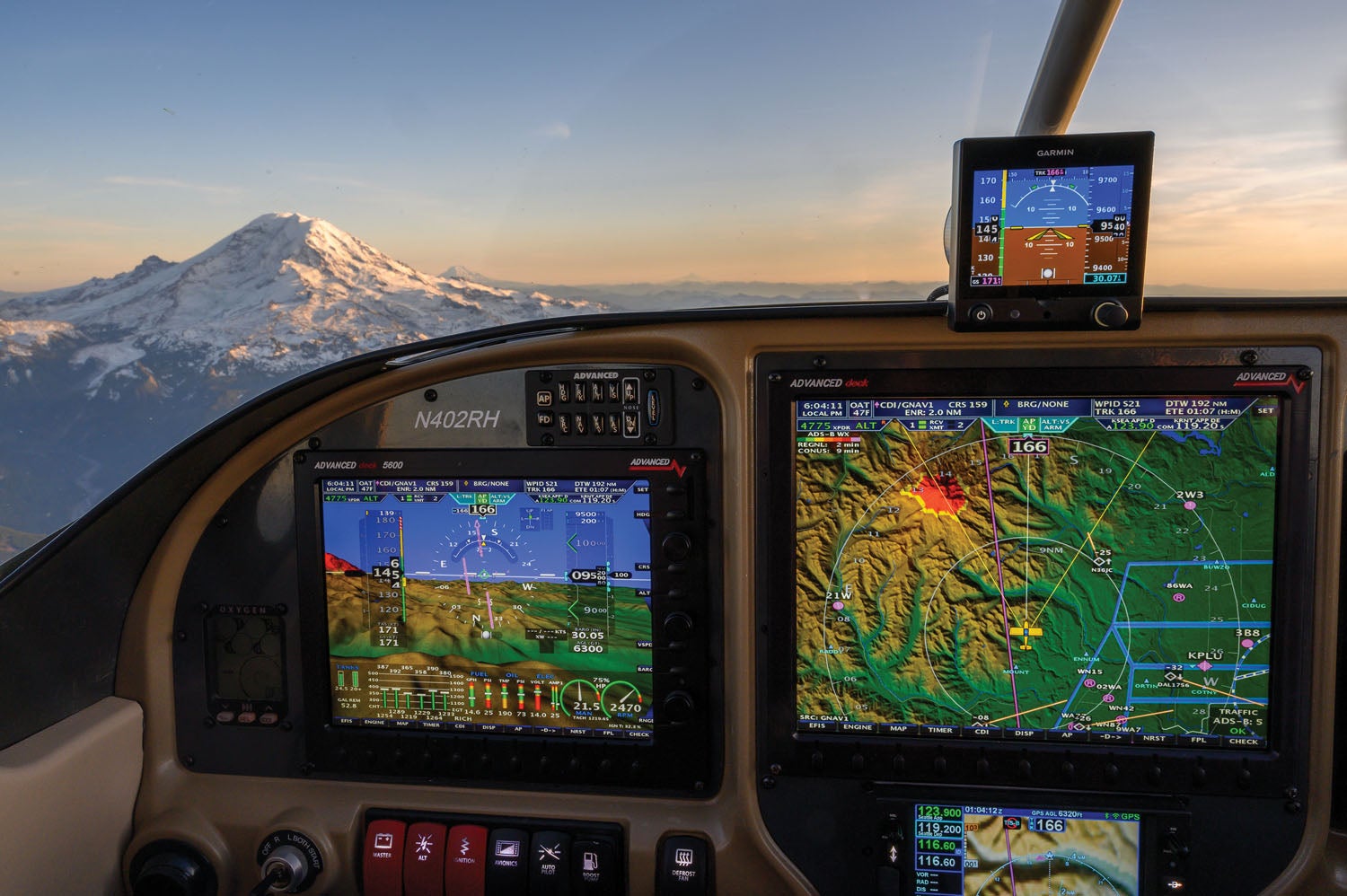
Bigger May Be Better
When shopping, you should always think of the installation and upkeep. Will you do it all yourself or farm some or all of the project out to an avionics shop? Make an honest assessment of your wiring and metal-building skills. For completed kits that need an upgrade, the thought of tearing the panel apart (and building another one) to accommodate a big screen may not be attractive. For those retrofit projects currently equipped with a traditional six-pack of round flight instruments, a small-screen EFIS will likely be an easier upgrade because you might be able to use the existing instrument cutouts and leave the cutting tools in the drawer.
We define “big-screen” EFIS as 7- to 12-inch screens, which by default serve double duty as multifunction displays (as opposed to primary flight displays) since they can accommodate lots of data. How much data? How many screens? That’s where it can get tricky and more expensive.
You’ll find that plenty comes standard even on entry-level displays, but you should make a list of the specific data you expect to display, like approach charts and weather graphics. And what about Bluetooth connectivity and instrument backup? In almost every big-screen EFIS interface, in addition to flight data, your eyes will be looking at engine, fuel and electrical data and, in some cases, electronic circuit breakers. See the May 2022 issue of KITPLANES® for more on electronic bus integration.
Also, consider the external architecture of the interface. Will you build your own harness or source a suite with prefabricated bundles that plug into a wiring hub, like the Advanced Control Module, to name one? That could also make it easier to add to the EFIS suite later on. The initial installation could be getting easier yet. At press time, Dynon introduced the FastTrack installation hardware—a simplified and modular approach to the mounting trays, brackets and harness assemblies that are part of an EFIS install and FastTrack is intended to streamline the install.
Last, consider the onscreen presentation—bigger is almost always better. Do you want synthetic vision, traffic, weather and terrain? For an IFR panel, of course, you do, and a smaller big-screen EFIS (a 7-inch model, for example) is going to get cluttered in a hurry. Consider a bigger one, a secondary smaller one to spread the data out or add a tablet computer to the mix. And speaking of data, aging eyes will simply get along better with larger screens. Last, can you customize the onscreen data to your liking?
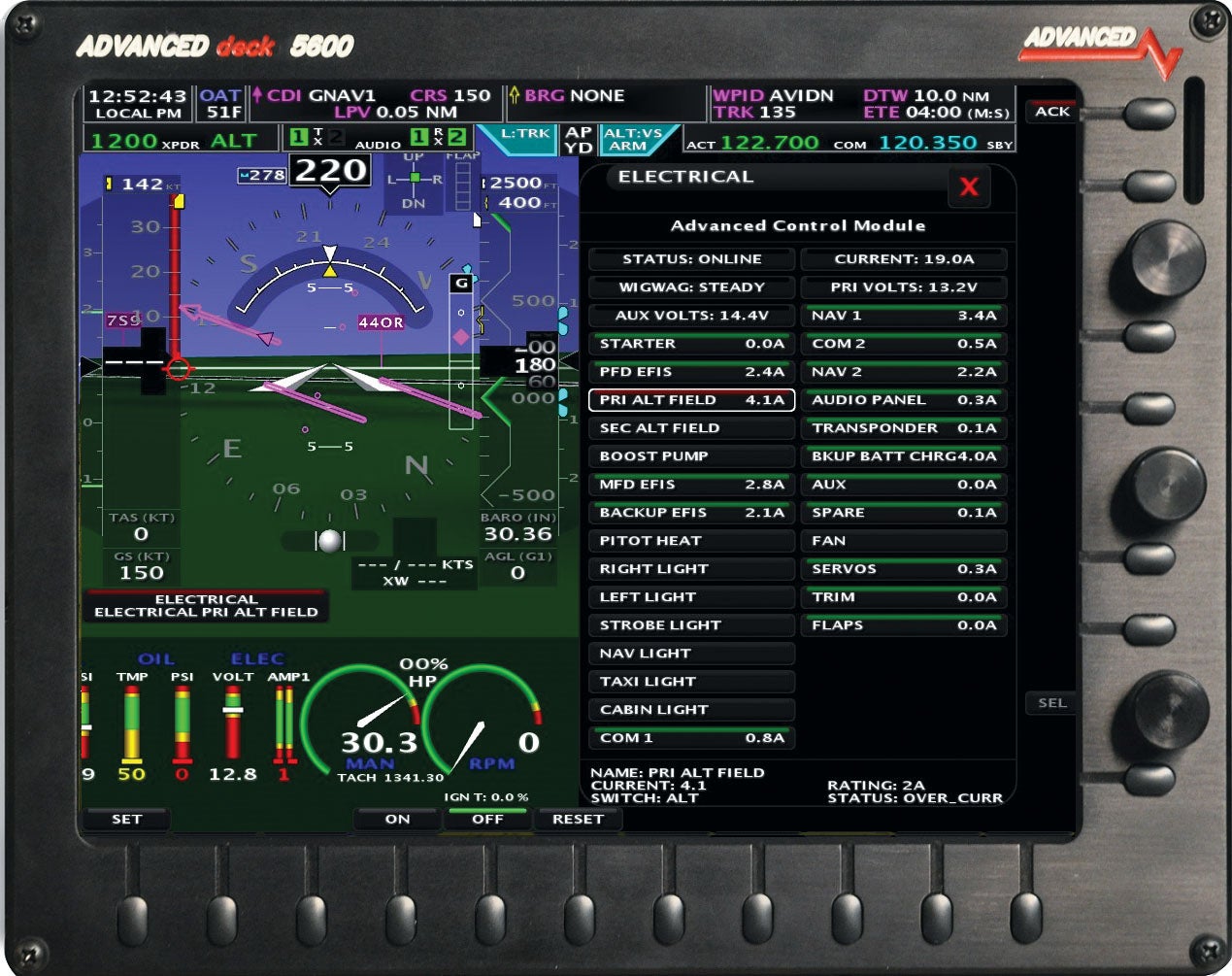
Advanced Flight Systems
Advanced has been operating under the Dynon umbrella for a while, although it was originally founded in 1999 by Rob Hickman, an electrical engineer with a software background who created an engine monitoring system for the Van’s RV-4 he was building. These days the company concentrates on its AdvancedPanel build program. Think turnkey: Advanced takes care of the entire panel (and in some cases the circuit breaker and bus interface) build process that can shave hundreds of hours from a project. When complete, you’ll receive a ready-to-install panel with preconfigured, pre-wired avionics already installed in a powder-coated and silk-screened custom panel. Choose your displays.
The line of Advanced Flight big-screen EFISes includes the AF-5000 series. These synthetic-vision-equipped 4:3-ratio-format displays (the Dynon HDX and Garmin G3X Touch aren’t 4:3, but widescreen, as an example) come in a variety of sizes and have a combination of 21 buttons, three knobs and a touchscreen, plus a joystick.
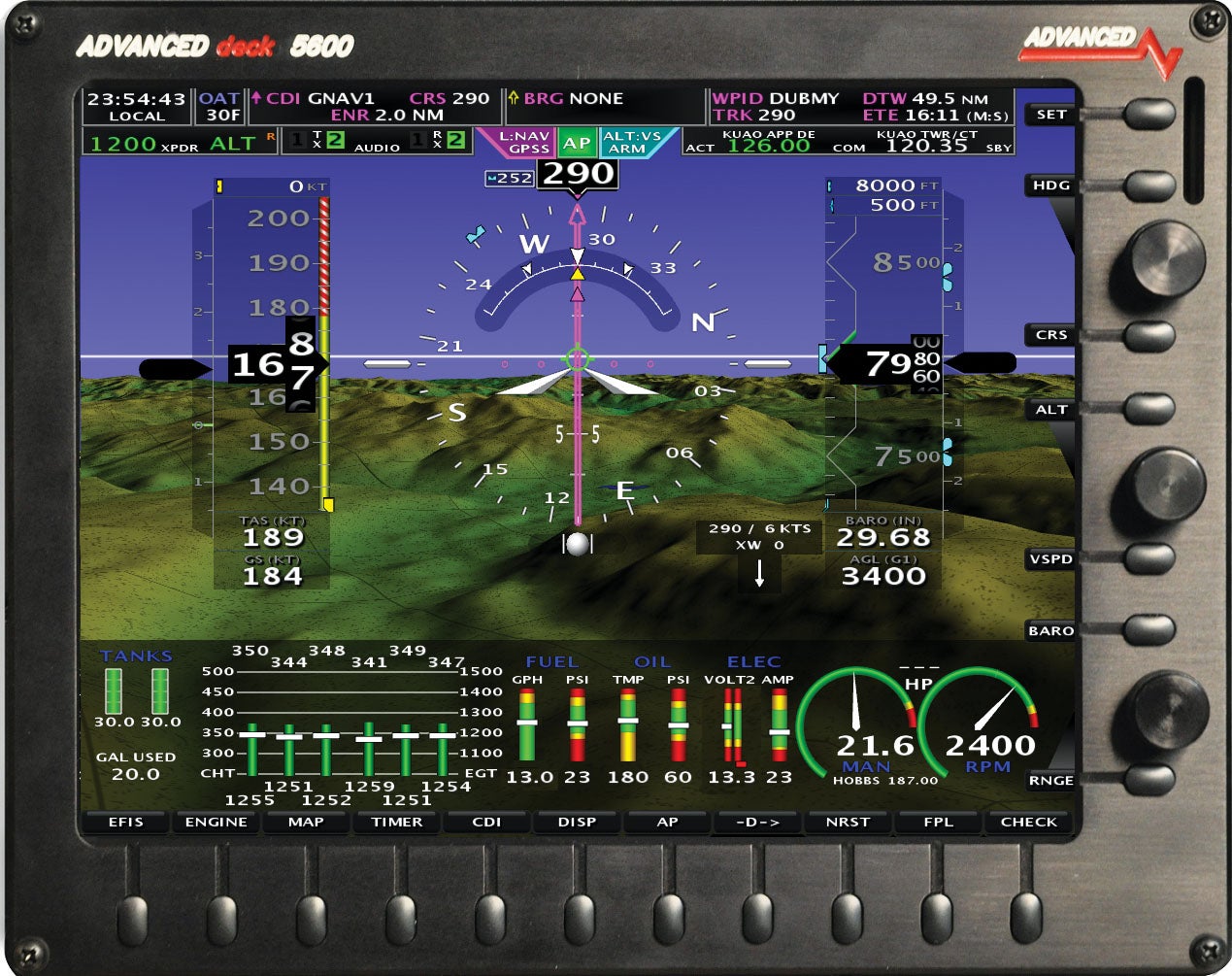
We like that this hybrid control set caters to a wide variety of users who will use a combination of touch and hard controls for data input. Initially, the Advanced line seems confusing, but just remember that all of the Advanced displays are essentially the same but differ by chassis and screen size. And since Advanced Flight Systems is part of Dynon, internally, the systems share the same memory, processors and electronics as the Dynon SkyView HDX system. They also use the same supporting accessories as Dynon, including Dynon’s autopilot servos, ADS-B Out transponder, com radios and so forth. Since EFIS tech is a moving target, we like that Advanced hasn’t left early customers in the dust, and it offers an easy upgrade to its latest gear without a complicated install.
For instance, if you have an early-gen Advanced display, the $4495 model AF-5400 is designed as a drop-in replacement for the company’s AF-3500/4500 series displays. The 8.4-inch display resolution is 1024×768 pixels—the same as all of the other screens in the Advanced line. They’re crisp, bright and do well in sun-splashed cabins. The AF-5400 hardware’s overall footprint is 8.1×6.8×3.7 inches, so there’s no need to cut the panel if going from the older Advanced 3500/4500 series. That obviously saves a lot of hassle.
But if you don’t have anything, there are really three display options to choose from when starting from scratch. Think 12-inch, 10-inch and 8-inch screens, all sharing the same screen resolution, control knobs and feature set. The AF-5500 is an 8.4-inch touchscreen starting at $4000 and might be the starting point in basic VFR installs. You’ll still need the Dynon SV-ADAHRS-200 flight instruments module, EMS-220 engine monitor sensor kit and a GPS system.
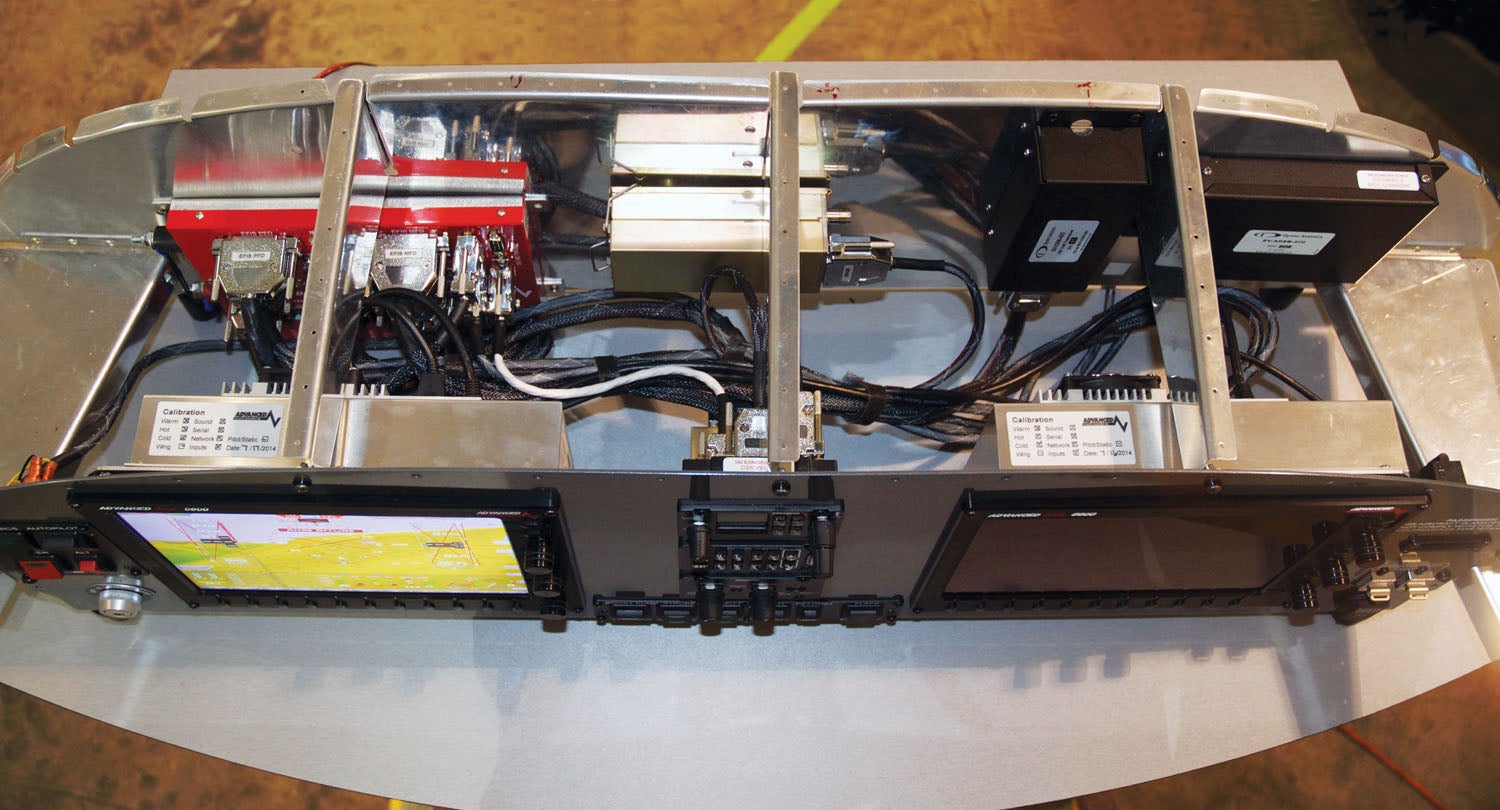
For that basic single-screen, VFR mission, you might follow the lead of the company’s well-equipped VFR AdvancedPanel, which includes a 5500 PFD, AHRS, one com radio, an ADS-B Out compliant Mode S transponder, a WAAS GPS navigator, two-place stereo intercom, AoA, autopilot servos, WiFi module for tablet interface, switches and audio jacks and the engine monitor module. The center of the interface is the Advanced Control Module for plug-and-play upgrade compatibility. That’s pretty much the meat and potatoes of the entire suite.
For a combination of VFR and IFR capability, Advanced said the most common seller is the $4490 AF-5600. This is a 10.4-inch diagonal touchscreen display (1024×768 pixels) with a chassis that measures 9.125×7.125×3.75 inches. Of course, you can connect multiple displays together (now or later) to expand the suite. While the 5600 is a touchscreen display, it has 21 bezel buttons, three control knobs and a joystick.
The $5200 AF-5800 is the largest Advanced display, at 12.1 inches diagonal, and it uses the same control set as the AF-5600. This is for select applications, and that bezel size simply won’t fit the majority of panels. It’s huge, although it has the same 1024×768 pixel count as the 10.4-inch screen.
To confuse matters, the $4800 AF-5700 model is also a 12.1-inch display, but to get the absolute most screen real estate, Advanced eliminated the buttons and knobs on the right side of the bezel. Moreover, this display was designed for the center of the Van’s RV-10 panel. It’s essentially the largest LCD touchscreen that fits the Aerosport carbon fiber panel. Think of it as a big MFD map, while the second (or third) screen is a PFD.
It’s got decent ergos, too. We like that the joystick on the PFD can control the big map in the center of the panel, eliminating the need to reach for the center display. You’ll find the AF-5700 in the center of the company’s RV-10 demonstrator.
In multiscreen suites, any of the Advanced screens (which have multifunction feature sets) can be configured as an EFIS, engine monitor or both, using the company’s CAN bus interface. When connecting an EFIS screen with an engine display screen using the Advanced Avionics Bus, the user has a variety of options, including the ability to display the primary flight data, engine monitor or both on either screen. There’s also an optional angle-of-attack module that can be added to any screen.
As for data, the split-screen capable Advanced displays are loaded with nearly everything you’d expect from a modern EFIS. There’s an integrated weight and balance utility complete with an intuitive airframe loading graphic, plus built-in configurable aircraft maintenance logs to keep track of an endless list of items for inspection and replacement. For nav data, there are geo-referenced approach plates, VFR sectional charts, IFR low airway charts, plus highly detailed airport and airspace information.
Making the transition from traditional flight instruments to EFIS? The AF-series display can be user-configured for an electronic depiction of a standard six-pack instrument display (including an analog HSI). GPS and raw nav data are fed in through a variety of third-party GPS navigators (Garmin and Avidyne), and the EFIS is fully compatible with WAAS GPS for vertical guidance, of course.
The engine monitoring functionality isn’t limited to engine and fuel flow and quantity data (or to pistons—there’s a turbine interface, too). There’s wing flap and trim position sensing and indication (compatible with most trim motors), speed-programmable landing gear warnings (including runway/water alerts for amphibs), voice alerting for stuff like low oil pressure, for example, checklists, 50 hours of data logging, leaning assist mode and full integration (via a dedicated electrical system page) with the Vertical Power VP-X electronic circuit breaker power system.
The IFR AdvancedPanel adds an Avidyne IFD540 GPS navigator, PS Engineering remote Bluetooth audio panel and a backup EFIS instrument.
The AdvancedPanel program is currently available for Van’s RV-7/8/9/10 and 14 models, Glasair Sportsman and GlaStar, Zenith, Lancair 360/ES/IV/III, Kitfox, Sonex, CubCrafters, RANS S19/S20, Bearhawk and some others not listed here. Advanced said it will work with builders on unique projects. Pricing is all over the board—basic single-screen Advanced suites can be had for under $10,000, while flagship Advanced panels with multiple big-screen models can easily top $35,000.
Dynon Avionics
The Dynon SkyView suite soldiers on, and the company offers three choices of its popular SkyView system. For the most basic, bare-bones setup in a simple VFR aircraft, you might start with the utilitarian SkyView Classic, which doesn’t have a touchscreen interface and starts at $2395 for a 7-inch (800×480 pixel) screen configuration and $2995 for a 10-inch (1024×600 pixels) single screen. Dynon also has bundle pricing with harnesses and synthetic vision.
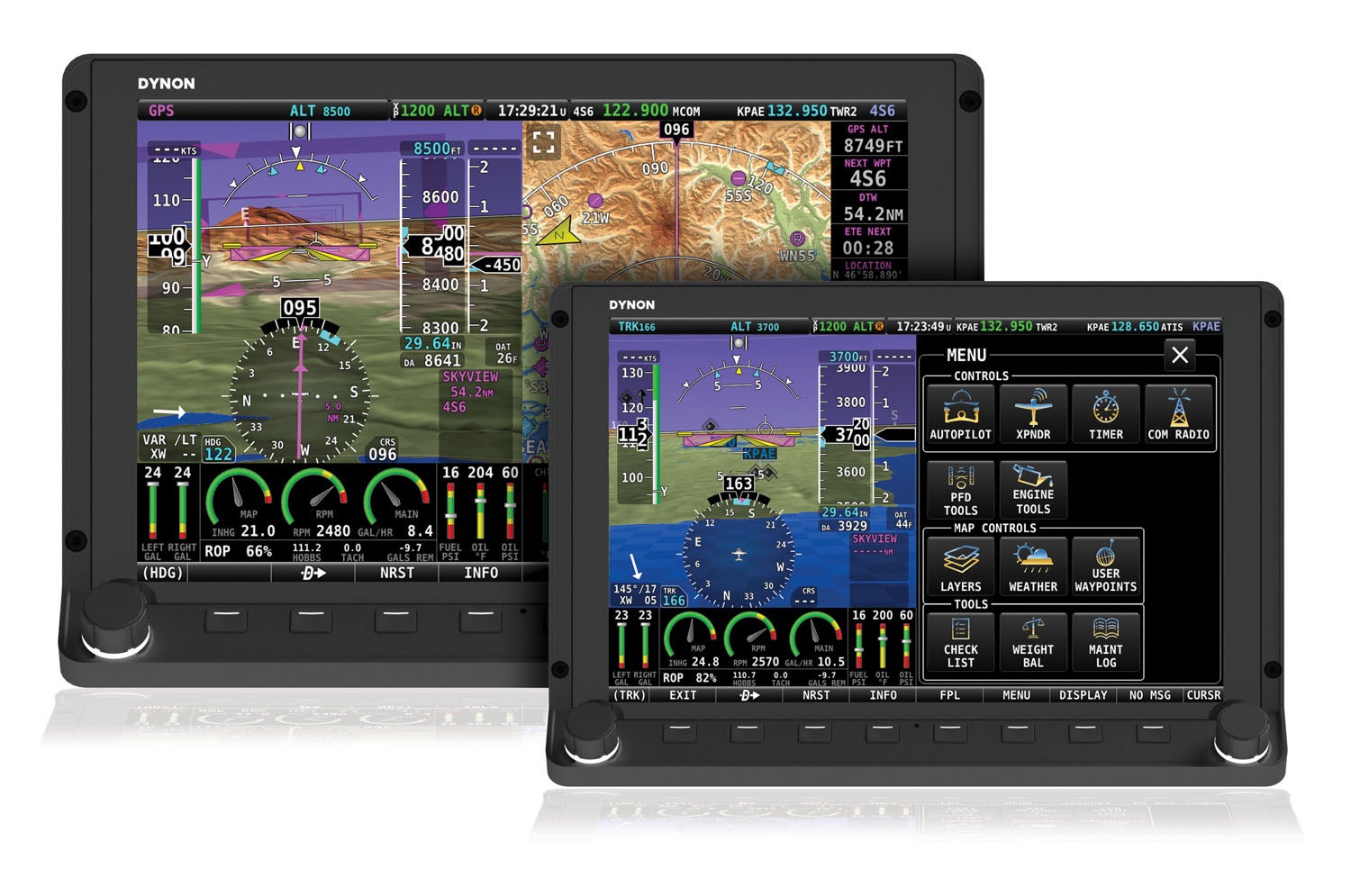
These displays are TFT active-matrix LCD screens with LED backlighting and are controlled with a combination of two rotary/multi-direction joysticks and eight bezel buttons. In a dual-display setup, one is a PFD, and the other is an MFD, but both have full reversionary. There’s also a backup battery (one for each display) for roughly one hour of standby power.
SkyView can display many combinations of PFD, engine and moving map data in full-screen and split-screen configurations, as well as distribute this data across multiple displays. For example, you can customize the screen to display flight instruments, terrain and engine data or toggle some of it off altogether. Do you prefer a full-screen engine presentation or half engine data and half map or half flight instruments and half engine? You get the point; the choices for layout are liberal.
In a dual-screen configuration, the system synchronizes the most important information between the two displays, so setting baro, bugs, engaging the autopilot or acknowledging warnings only needs to be done on one display. As for navigation, the PFD’s HSI display is mostly traditional with a magnetic compass rose (with cardinal points displayed in letters), heading bug and a rate of turn indicator. A cyan-colored ground track GPS pointer is located on the inner area of the compass rose. Comparing GPS track to your heading quickly shows the difference between where the aircraft’s nose is pointing and where it’s actually going over the ground. However, a track bug replaces the familiar heading bug when the autopilot is flying in GPS ground track mode.
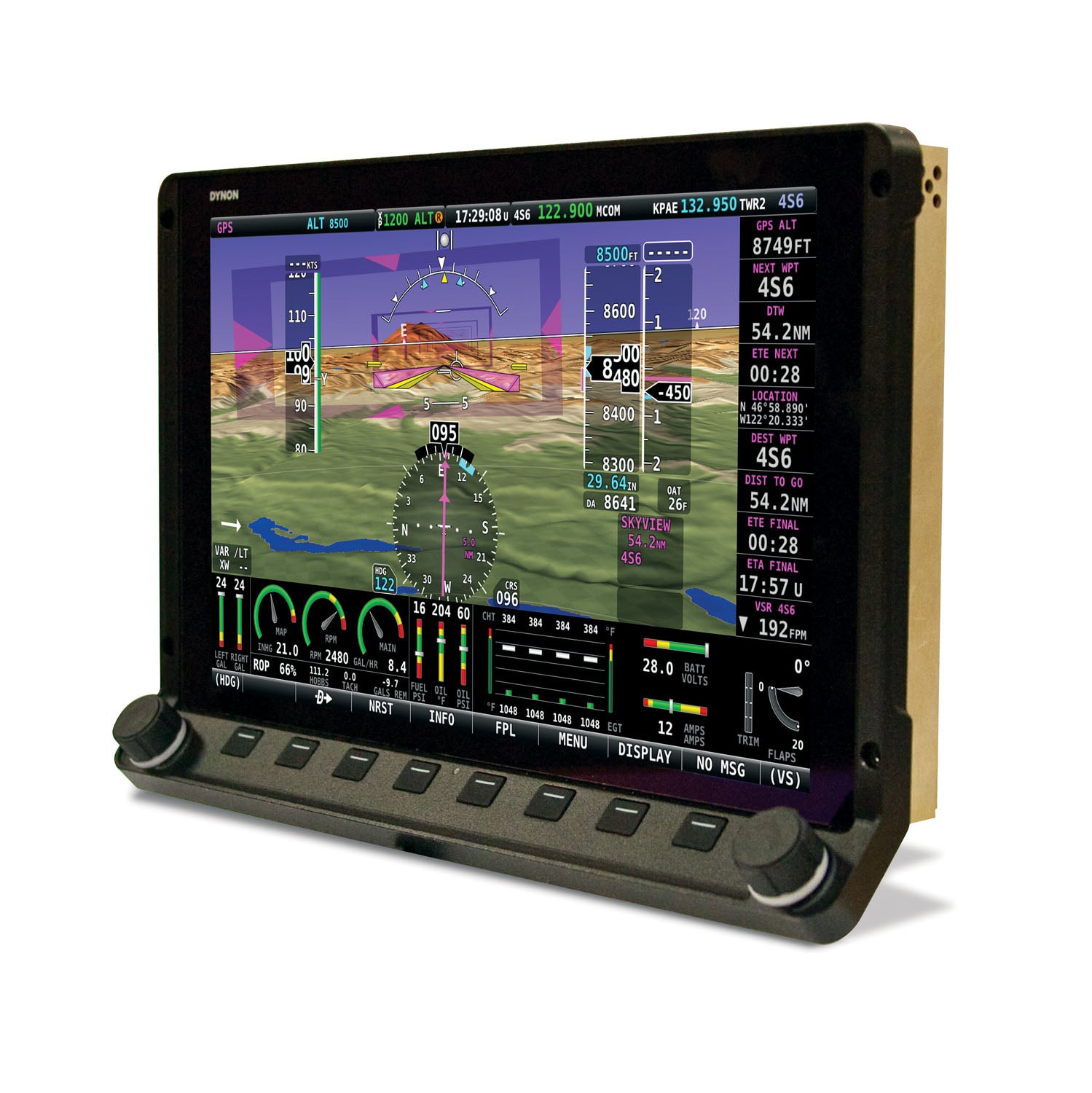
Synthetic vision is practically required for a glass panel, and SkyView presents it well on those big, crisp displays. We won’t cover the specifics of synthetic vision here to save space, but even the classic non-touch SkyView does a decent job of playing the familiar flight path marker (depicting the actual trajectory that the aircraft is flying through space), synthetic runway and surrounding environments—painted an eye-catching yellow or red as they become a threat.
The SkyView comes standard with a basic topographical map display that shows advisory terrain color-coding and basic active waypoint information when driven by an external GPS. But the addition of Dynon’s GPS module and one-time navigation mapping software adds an advanced embedded GPS navigator function and an extensive aviation database for interactive onscreen navigation. Of course, for full IFR GPS nav and approaches, you can connect a variety of GPS navigators from Garmin and Avidyne.
SkyView is compatible with Rotax, Lycoming, Continental and several less-common engines. Engine data comes via the SV-EMS-220 engine-monitoring module and related sensors. It supports many parameters, including rpm, manifold pressure, oil temperature and pressure, EGT, CHT, fuel levels for multiple tanks, bus voltage, current, fuel pressure, fuel flow, carburetor air temperature, coolant pressure and temperature, flap and trim potentiometers, external contacts and general-purpose temperature sensors.
There’s also an interface for the Vertical Power VP-X electrical system monitoring system. Further, the installer can custom-configure the engine gauge presentation and location of the gauges on the screen.
As for connections, each SkyView display contains a 37-pin D-sub connector for the main wiring harness, a 9-pin D-sub connector for the SkyView network and an Ethernet connector that’s used to sync the data between two displays. A main wiring harness is required for each display, and they’re sold separately.
The SkyView HDX is the Dynon model you’ll want to look at for the majority of IFR applications, and the HDX picks up where the classic system left off. For a basic VFR installation, you’ll be eyeballing the $3304 single 7-inch (800×1280 pixels) high-definition touchscreen display, and as an option to go bigger (or for panels that fly a combination of VFR and IFR), the $4604 10-inch (800×1280 pixel) high-definition touchscreen. Or, mix the two—a 10-inch HDX for the PFD and a 7-inch as a second screen. These both come with display harnesses but require external flight data sensors.
For planning, the larger display is 10.31×7. 1×3.1 inches, and the smaller one is 7.64×5.59×3.13 inches). We like that the upgraded HDX uses the same components and modules as the Classic SkyView, and they can drop into an existing installation without having to cut. The HDX has eight soft keys and two control knobs, plus there’s an option for external panel-mounted controllers.
The HDX’s touch functionality simply adds another layer to the user interface, and overall, we think it’s logical. For instance, if you want to change the altitude or airspeed bug on the PFD’s altitude and airspeed tape, touch the corresponding tape and use the left joystick knob to alter the bug setting. The same goes for changing the baro setting and almost any other common function that you work with on a regular basis, including remote nav and GPS source annunciators that display on a dedicated box next to the EHSI.
The HDX’s PFD has synthetic vision, a map display with a variety of customizable layouts and an EMS or engine monitoring system. Just like with the Advanced displays, the data to drive the Dynon display comes from external modules, including the AHRS, pitot tubes and autopilot servos. There’s also an external com radio, an ADS-B 1090ES transponder and an ADS-B weather and traffic receiver.
As for architecture, these use the redundant SkyView Network to communicate with the displays over RS-232 serial ports with configurable baud rates and all serial ports are wired into the SkyView Display Harness. Each display has a USB port on the rear chassis for file transfer and software updates, and there’s an external USB port mounted on the instrument panel. There’s also an optional WiFi adapter.
If you’re struggling with the Classic versus HDX in even a basic VFR application, consider that the HDX screens have a wider viewing angle, are higher-resolution (high-definition) and have antireflective properties that, in our view, make them superior to the original. There’s also a new engine monitoring presentation that’s contained in a band along the bottom of the screens.
Dynon worked hard to make the HDX touchscreen displays turbulence friendly, with wide sculpted bezel rails for anchoring the hand in the bumps. There are also redesigned knobs (they can be pushed and rotated for a variety of functions) that we think have a much better feel than the ones on the Classic. The controls are also backlit.
For display presentation, primary data, which is PFD, engine and moving map data are selectable for display on the entire screen, while optional content (map, engine and also PFD data on a second screen, for example) can be displayed in a 50% split window. The HDX screen data is nicely configurable to your liking.
As for supporting components, the SkyView systems use a primary and secondary (for backup and crosscheck) ADAHRS for deriving the flight data. And yes, the PFD can be configured in the modern tape display or digital six-pack flight instruments. In multiple display configurations, data and inputs are automatically synchronized across the displays. The HDX has internal data logging of flight data. The system has an internal magnetometer for heading resolution, but there’s also an optional external magnetometer for installing remotely if the internal mag has interference issues.
The EMS (engine monitoring system) is required for engine data display. It’s a $600 option and is available with sensor/harness packages for Lycoming, Continental, Jabiru and Rotax engines. Got a Rotax? The model EMS-221 is designed to receive engine data directly from a Rotax 912 iS/915 iS engine computer via a dual-channel CAN bus interface.
There’s also synthetic vision software, autopilot servos (the systems have built-in autopilot functionality) with mounting kits for various airframes, versions and multiple torque settings (36, 42, 52 and 72 inch-pounds). For cable-driven control surfaces, servos are available with capstan drives. All Dynon autopilot interfaces (also when connected to the Advanced displays) have full approach coupling (including VNAV), indicated airspeed hold, flight director guidance, a LEVEL button for return to straight-and-level flight and something we like the most—an emergency 180° turnback mode for exiting inadvertent IMC.
If you want to control the autopilot externally from the display, Dynon offers the $550 dedicated autopilot control panel. This controller has a high-quality feel with backlit buttons and an integral dual-axis speed-sensitive trim control for commanding pitch and roll trim motors. There’s also automatic electric pitch trim.
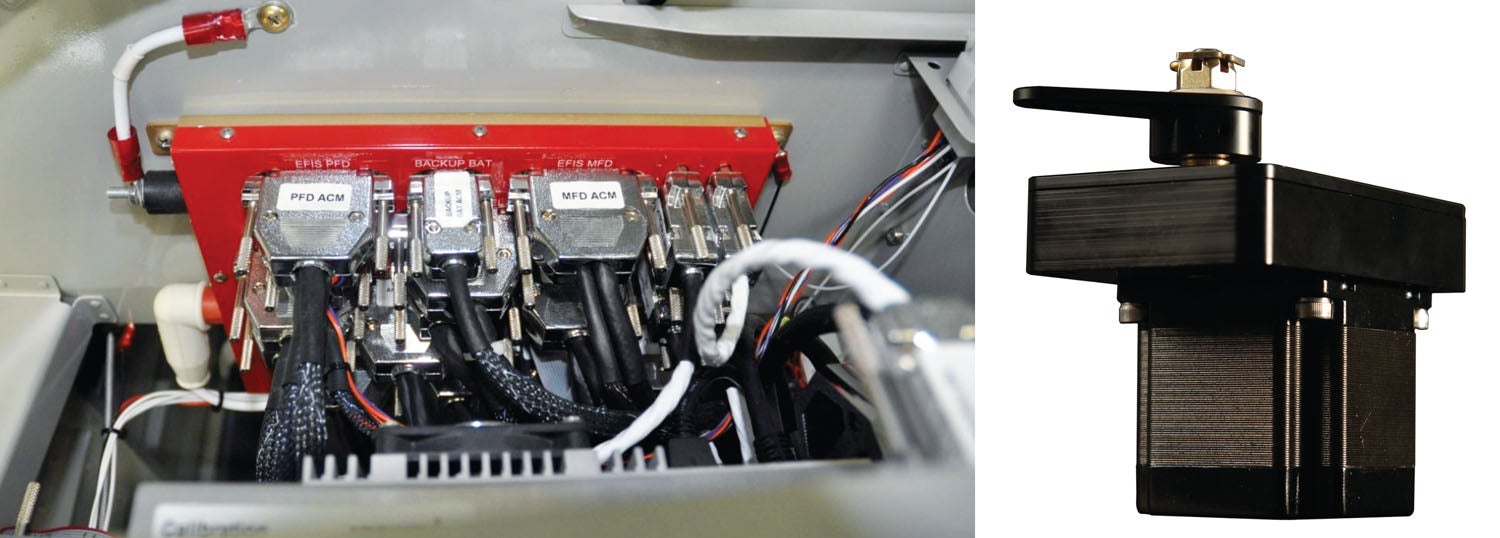
Speaking of external controllers, there’s an optional $250 dedicated control knob panel with three knobs for setting the baro, heading bug and altitude bug. Like the autopilot controller, the control knob panel installs inline for plug-and-play with the SkyView network without any additional wiring. It’s 1.27 inches deep and is available in vertical and horizontal mounting configurations.
The HDX has a built-in GPS moving map and dual external GPS receivers for positional data and for map navigation, but for IFR GPS functions, you’ll need an external GPS navigator. Garmin and Avidyne models are the most popular for approach capability. The map has aviation and obstacle data, as well as VFR and IFR en route charts and approach plates.
For more VFR options, Dynon sells the SkyView SE. The 7-inch display is $1609 (bundled with a harness), and the 10-inch display is $2609 with a harness. It’s stripped down and has no mapping capability, no synthetic vision and no interface with an IFR GPS. That’s because the Arinc 429 adapter used to connect a SkyView system to the navigator won’t work with the SE. The SkyView SE does support an engine data display and can interface with Dynon’s remote com transceiver and Mode S ADS-B Out transponder. The SE doesn’t have a touch interface and essentially no submenus in its feature set.
Worth mentioning is that as we go to press in mid-March 2022, some Dynon components (including the 7-inch SkyView SE displays) were not available due to global parts shortages.
Garmin G3X Touch
Garmin—with its newly introduced G3X Touch—showed up at Sun ’n Fun way back in 2014 with a focused effort on dominating the LSA and Experimental market, even though Dynon brought its new SkyView Touch. The G3X Touch turned out to be big competition for Dynon and others, and a huge number of LSA and Experimental kit OEMs selected the new G3X Touch as original equipment. Garmin’s G3X Touch can be configured with up to four 10.6-inch high-resolution WVGA screens.
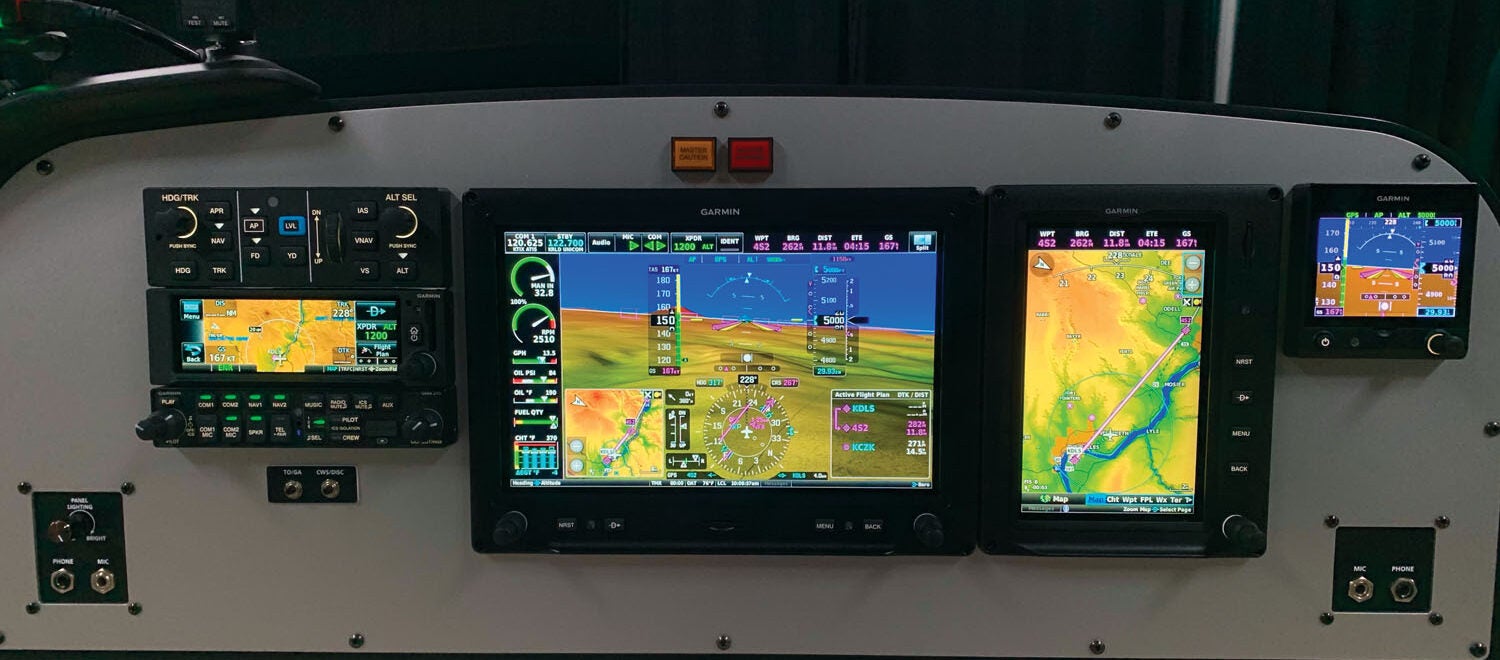
For basic VFR missions, you might choose the $3085 7-inch landscape (or portrait) single-screen configuration. There is a lot of data packed into these little screens, which starts with a split PFD and MFD presentation, but multiple display suites are configured for dedicated PFD, MFD or a combination of split screens on all. If you’re upgrading from the first-gen G3X, the current Touch version will be worlds ahead. And while the G3X Touch is plug-and-play with the second-generation G3X components, you’ll need to do some panel cutting to make the new displays fit.
For a combination of VFR and IFR capability, you might select the $3985 10.6-inch screen, with a second 7-inch portrait (or landscape) screen added for use as an MFD. You could expand the interface even further because the G3X Touch has Garmin’s Connext wireless system built-in. This sends flight plans, weather and traffic data out via Bluetooth to tablet computers when running Garmin’s Pilot app.
A flagship G3X Touch might have as many as four displays in various configurations. Maybe two 10.6-inch displays for PFD and MFD (or pilot and copilot PFD, plus a dedicated MFD) and a smaller 7-inch screen for displaying engine and airframe data. Transponders, autopilot (GFC500) and SiriusXM receivers are all optional compatible accessories for piping into a G3X Touch display, as are external GPS navigators, including the GTN, GNS and Garmin’s latest budget-based (non-VHF nav) navigators. You can interface Garmin’s $1199 GTR 200 (or $995 remote GTR 20) VHF com radios, plus the $1445 GMA 245 or GMA 245R (remote) Bluetooth audio panels. The functions are accessed on the G3X Touch screens as dedicated functions.
But even in the simplest configuration, the G3X Touch flight displays come standard with VFR internal GPS and what Garmin calls dynamic moving maps. This means you touch anywhere on the map, and based on your current position, the display shows the distance, bearing and time to that location on the map—as well as the elevation and GPS coordinates for that location. There’s also a full-time bearing pointer for the nearest airport, plus visually extended runway centerlines. For basic local VFR missions, it’s capable as standard, if not bare-bones basic.

For charting, the G3X Touch comes preloaded with a variety of Garmin aviation databases, including geo-referenced FliteCharts, including IFR approach plates, plus IFR/VFR sectionals and terminal VFR charts. The system also has Garmin’s built-in SafeTaxi airport diagrams. When loaded, you’ll see a depiction of the aircraft’s location overlaid onto taxiways, runways, hot spots, hangars and other airport facilities.
When shopping, it’s worth comparing the G3X Touch with the Dynon SkyView HDX. From a hardware and software standpoint, the two couldn’t be more different. While primarily a touchscreen feature set, the G3X Touch also has a few dedicated control keys for performing some common functions, including direct-to navigation, finding nearest waypoints and accessing the main menu. It doesn’t have a full set of buttons and keys to alternately perform all functions as the Dynon does. For those new to touchscreen avionics, a so-called hybrid interface with knobs and buttons to fall back on is nice for those times when you’re lost in a menu or when fingers are slipping in the bumps. While Garmin offers this to a degree, it’s not to the extent that the SkyView Touch does.
We think most users will find that the G3X Touch is intuitive. As we’ve noted in the past, we still like that common functions can be accomplished with the screen’s traditional bezel knobs. The knobs (one on each side of the bezel) can be used for frequency tuning, scrolling and a variety of other functions. As simple as it is to enter radio frequencies on a touchscreen, we still prefer cranking the knobs for the task. Each Garmin display has a clean, uncluttered bezel. The data card slot on the lower portion of the bezel accepts standard SD cards. The SD card can be used for a variety of functions, including software updates, storing checklist files, flight data logging, exporting track logs and user waypoints and importing/exporting flight plans.
Following the lead of other Garmin navigators, the G3X Touch system has a page navigation bar displayed on the lower portion of the display. You can touch the desired page on the page navigation bar or turn the large knob associated with the MFD to cycle through the pages. Main pages that are accessed on the MFD include the map, electronic charts, waypoint information, active flight plan, optional SiriusXM weather, terrain, traffic and optional engine data.
The system has a full EHSI (electronic HSI) with the ability to display two bearing pointers for traditional nav and GPS sources, plus bearing to the nearest airport. When a bearing pointer is displayed, its associated information is displayed in a bearing data window at the lower side of the HSI. This takes the guesswork out of figuring out which nav source is associated with a given bearing pointer.
Supporting Components
Any G3X Touch suite requires the $370 GMU 11 three-axis solid-state magnetometer/heading sensor. It’s the same one that works with Garmin’s smaller G5 flight instrument. It typically mounts in the outboard section of a wing or the tail section and is a critical component in the installation. There’s also the $499 GAD 29 navigation data interface adapter. This ARINC 429 data bus module is what interfaces Garmin’s GTN and GNS-series navigators (up to two units) to the suite. For engine data, any G3X Touch configuration requires the GEA 24 EIS or engine indication system.
There’s an angle of attack option, and like the Dynon system, it requires the optional heated AoA probe. There’s also the $1549 GI 260 AoA indicator for mounting on top of the aircraft’s glareshield. AoA functions are customized in the system setup, which determines when AoA warnings appear on screen. For instance, when the AoA is below the calibrated minimum visible AoA threshold, the angle of attack gauge is not displayed on the PFD. When AoA exceeds the calibrated caution alert threshold, an intermittent audible tone will be heard. The tone will increase in frequency until the stall warning AoA is reached, where it sounds continuously.
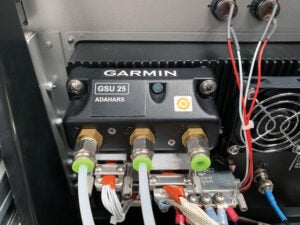
Garmin’s integrated autopilot for the G3X Touch brings many of the advanced features found in the certified GFC 700 (and now the retrofit GFC 500) and utilizes the compact GSA 28 digital servos that Garmin calls a “smart servo.” The GSA 28 servo is considered smart because it contains the software drive logic and doesn’t rely on a remote computer for roll and pitch commands. It’s available in single- or dual-axis, and the autopilot is commanded through and annunciated on the G3X Touch display. Garmin’s GMC305 autopilot control head also has a level mode in addition to duplicate mode select buttons.
The G3X Touch gets most of its primary flight data from the GSU 25 AHRS, which can be mounted in any of 16 different vertical or horizontal positions. Like the magnetometer, it’s a critical and major part of a G3X Touch interface. And speaking of interfaces, at press time Garmin announced the G3X Touch interface with its Smart Glide engine-out utility. When Smart Glide is activated, the G3X Touch creates a Direct-To route to the closest (within glide range) airport or it will tell you if there aren’t any. When the system is interfaced with the GFC 500 autopilot, it will fly you there automatically.
GRT Avionics
GRT Avionics (widely called Grand Rapids) offers multiple big-screen options in 10.1-inch and 7-inch sizes, but that’s where the simplicity ends. While we like that GRT gives buyers lots of options for adding or subtracting features (many through software upgrades), the à la carte nature of the product line is more difficult to digest than it needs to be.
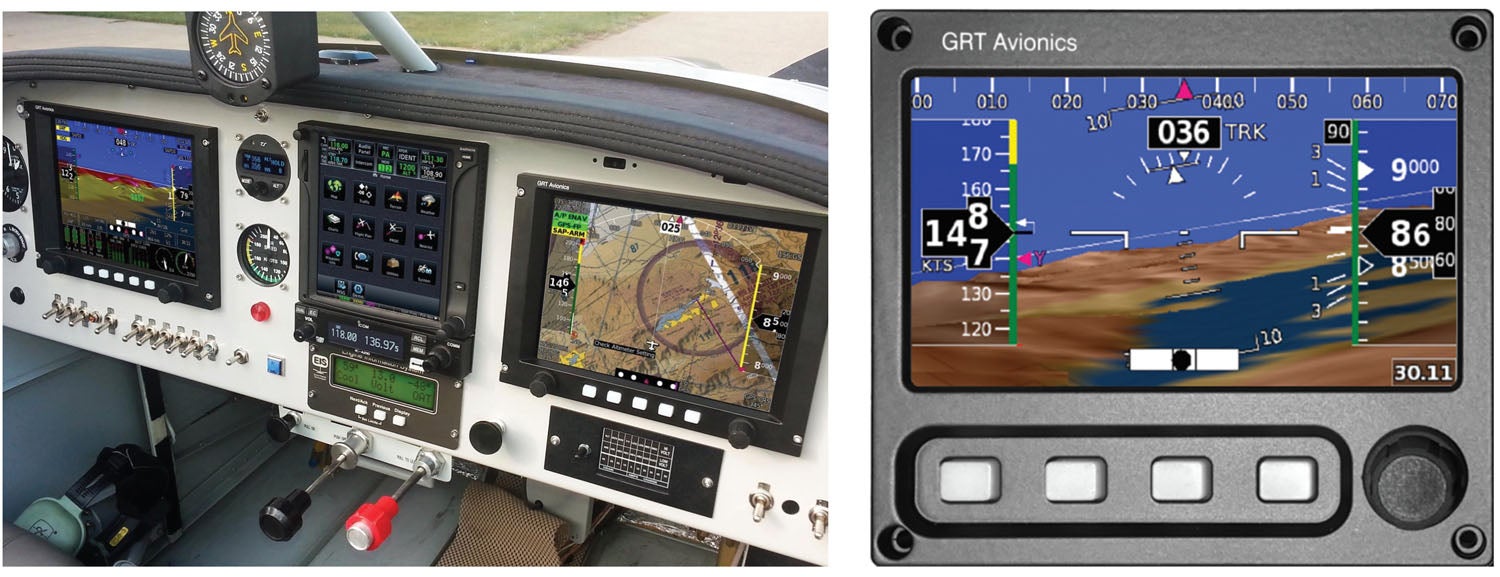
For basic VFR equipage, there’s the 7-inch $1600 Sport EX EFIS model, which includes the AHRS/Air Data sensor and a wiring harness. Synthetic vision is a $400 option, as is autopilot integration. The Sport is limited to six serial ports and two analog ports, and it can be driven by the GRT engine monitor. The $2100 Sport EX Basic package takes the interface one step further with a moving map and synthetic vision feature set.
The $2500 Sport EX Advanced package might be appropriate for VFR and IFR equipage. It has a moving map, synthetic vision, four analog data ports and three additional serial data ports. For $3100, there’s the Advanced Touch package which has a touchscreen, moving map, synthetic vision and IFR autopilot control. Compatible autopilots include GRT’s own servos, plus the Trio and TruTrak autopilots (requiring each brand’s external control head). You can connect a variety of third-party GPS navigators, including Garmin GNS/GTN and Avidyne models, plus a generous selection of ADS-B transponders, VHF com radios and weather receivers.
For advanced IFR capabilities, the flagship is the 10.1-inch Horizon model. With a base price of $4250, it has a high-resolution (1280×800 pixel) display with an internal AHRS/air data computer and measures 7×10.3×3 inches. GRT has a touchscreen version, but it charges an additional $250 for it. While that’s not big money, we think it should be standard in a flagship product. The digital magnetometer is $280.
What is standard in the Horizon 10.1 is a moving map, ADS-B display, synthetic vision, split-screen view, 12 serial ports, five analog input ports, aeronautical charting and approach plates, but internal IFR approach procedures are an additional $750. Third-party autopilot integration is standard. GRT’s digital autopilot servos are $775 each (roll and pitch), and the company offers high-torque models for an extra $100 each. Mounting kits are extra and are priced for particular applications.
There’s also an angle of attack option for $250, but it requires a dual-port pitot tube that’s not included. For the Sport model, the company charges $450 for a dual-AHRS option and $260 for a digital magnetometer. Engine monitoring comes from the EIS package, starting at $1210 for the basic kit that works on four-cylinder Lycoming and Continental models. You get CHT, EGT, oil pressure and oil temperature sensors, plus a wiring harness. The $1758 Advanced package adds fuel flow, fuel pressure and manifold pressure sensors.
GRT says it has more than 17 years of experience producing its own AHRS and uses MEMS technologies in its latest so-called Adaptive AHRS, which has the ability to operate unaided—or without air data input (the screens still require pitot-static input). Built into every Adaptive AHRS is a miniature magnetometer (for yaw stabilization only, not for heading resolution—that’s extra) and uses GPS ground track. Moreover, attitude data is unaffected by the loss of the external magnetometer—the way it should be, in our view. Instead, the AHRS automatically reverts to gyro-stabilized GPS ground track or its internal magnetometer.
Overall, we’re impressed with the GRT display feature set, display quality, engine monitoring accessories and its track record for reliability. We just wish the company would streamline the model lineup and add more functions as standard.
MGL iEFIS/MX1
Sales and support of the MGL line come from Michigan Avionics, and for basic VFR equipage, MGL has the $1995 (plus $250 for a harness) 7-inch iEFIS MX1. The touchscreen MX1 operates much like the MGL iEFIS Lite units (it has the same four rotary control knobs), but there are sizable differences and improvements inside and out. First, the MX1 is configured in portrait mode as opposed to landscape, with multiple pages of configurable split-screen data, including engine and ADS-B. You can also tune MGL’s VHF com radios and Trig transponders onscreen. There’s also a full-page map display.
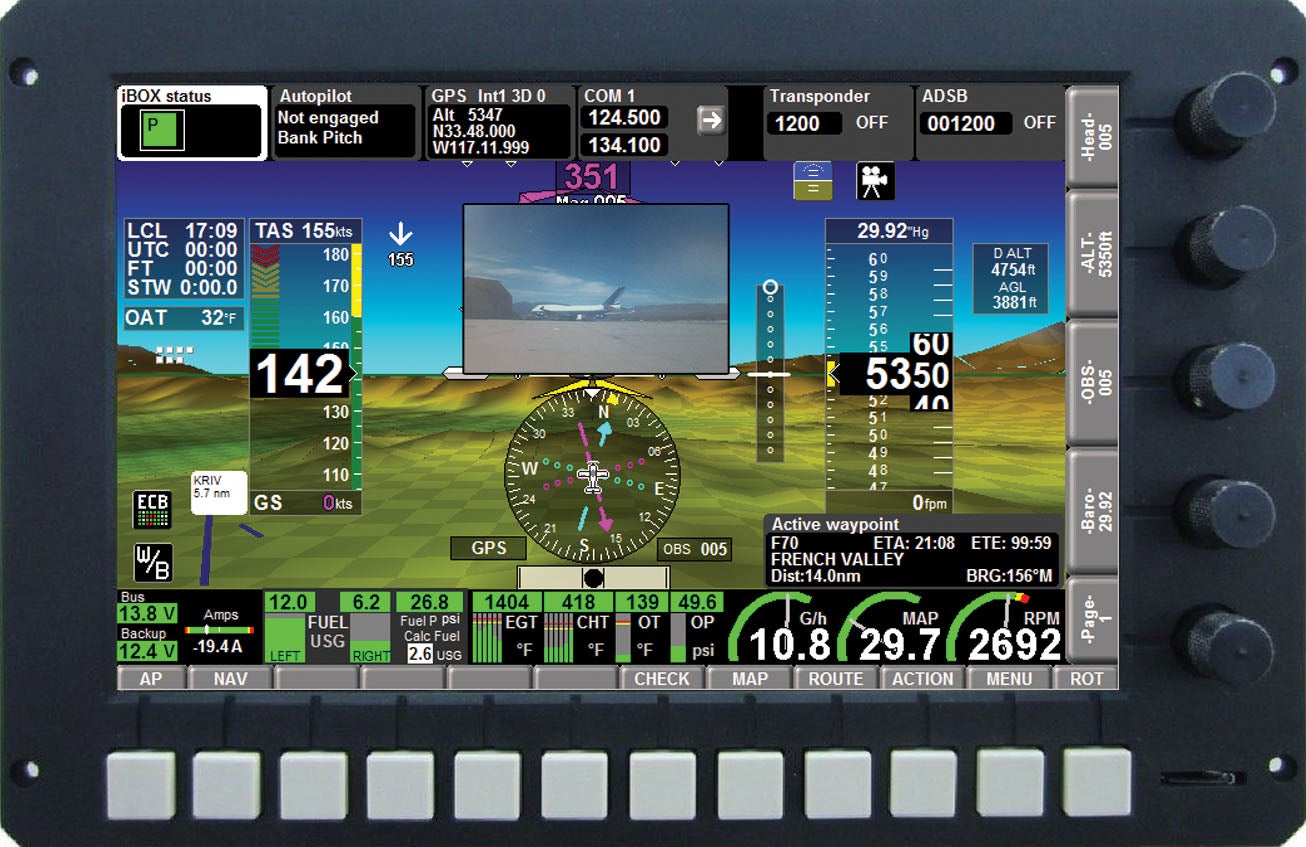
The MX1 has AoA as standard, with pitot-static inputs on the rear of the chassis, plus an internal WAAS VFR GPS. There is one 25-pin D-sub connector to feed the unit’s four internal RS-232 serial ports (ARINC 429 interfaces require MGL’s adapter), and there’s a coax connector input for the supplied GPS antenna. The MX1 has audio outputs for engine and altitude data, plus an OAT sensor. The MX1 works in aircraft with speeds up to Mach 1 and altitudes to 40,000 feet.
The MX1 has an internal autopilot interface when using MGL’s servos, and it supports TruTrak and Trig systems. The MX1 can cross-fill via RS-232 with up to eight displays wired in parallel over a single CAN bus, with one display serving as a “master” screen. If it should fail, the next one in the chain is a failsafe to function as the master. There is no synthetic vision terrain presentation.
MGL has retained the touchscreen iEFIS products available in a variety of configurations, and you build your own system with the web-based iEFIS builder utility. For basic VFR equipage, the iEFIS Lite includes the 7-inch Discovery, 8.5-inch Explorer and 10.4-inch Challenger. These have built-in VFR WAAS GPS receivers, integral air data computers and attitude sensors. The company suggests iEFIS Lite models for single screen (or basic two-screen suites).
We spec’d a single-screen starting at $1710, but you have to add what MGL calls the iBox—an interface hub—for adding external sensors and third-party equipment, including radios, transponders and autopilot servos. Autopilot control is standard, but the servos are optional.
Engine data display is accomplished with the CAN-bus-based RDAC or remote data acquisition computer, which mounts on either side of the firewall. Flight data comes from the $260 SP-6 CAN and SP-7 CAN AHRS sensors.
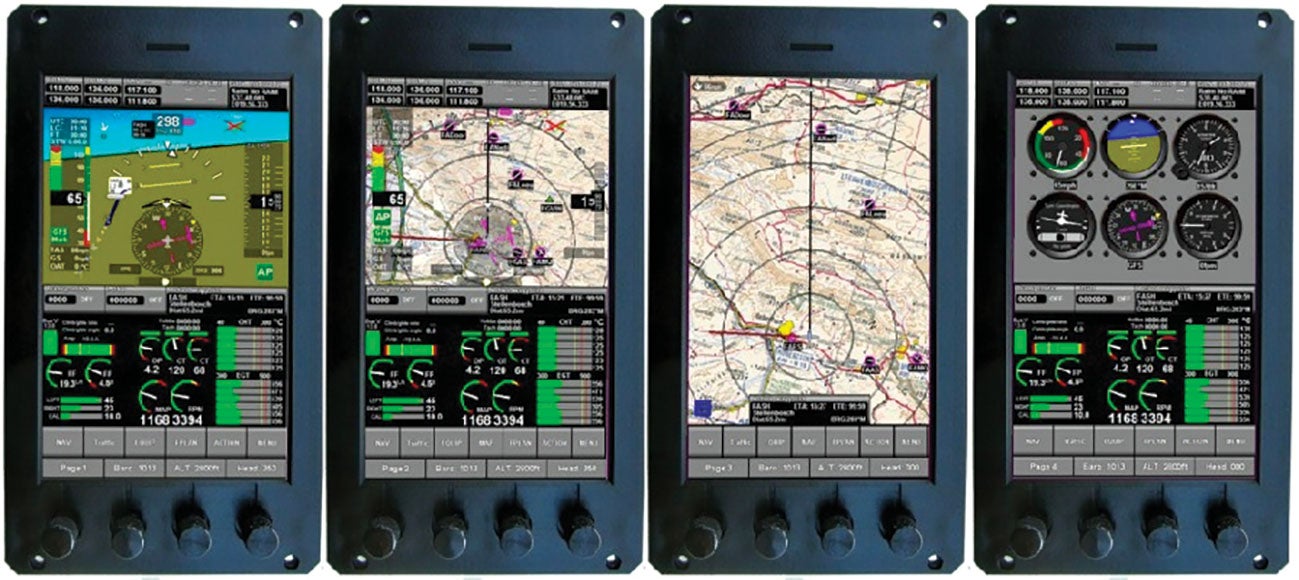
For a combination of VFR and IFR, the iEFIS Standard is available in the 8.5-inch Explorer and 10.4-inch Challenger. These are the MGL units to choose when you want a multiscreen suite with full connectivity between the screens for ARINC interfaces and analog inputs. These use MGL’s iBox adapter, which has a GPS receiver, pitot/static sensors and AoA sensor. Think of the iBox as a central communication hub for connecting the AHARS, autopilot servos, radios, transponder and other serial and ARINC devices. The iBox is a smart box, but if you want a more self-contained interface, look at the iEFIS Lite.
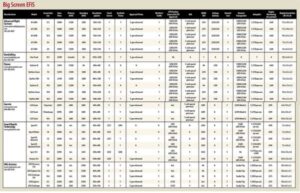
The iEFIS Lite is available in the 7-inch Discovery, the 8.5-inch Explorer and 10.4-inch Challenger. These touch displays have built-in air data computers, built-in attitude sensors, built-in WAAS GPS (not approach capable) and control over external com, nav and transponders. The MGL iEFIS Extender is required to add AoA, four additional RS-232 ports and multiple analog inputs. All displays require MGL’s external magnetometer.
All iEFIS displays come standard with synthetic vision and terrain data, a worldwide vector base map, airports, navaids and obstacle database. iEFIS systems are compatible with Garmin GNS/GTN and Avidyne navigators when equipped with the iBox adapter.
Conclusion
Our advice for selecting an EFIS is the same as it ever was: Try them before you buy them. See how well you get along with the feature set, study the interconnect potential and think well into the future. What you need now may change as your skill and mission expands. As mentioned, consider stepping up in screen size or simply add a second smaller screen to share the data.
As for install complexity, we like Dynon’s attempt at taming the dragon with its FastTrack option, and we still like the Advanced Control Module for plug-and-play upgrade and an easier initial installation, especially with prefab harnesses.
For simple aircraft with VFR missions, we think MGL’s MX1 is worth a look. It’s priced right, has smart interfacing, and it’s easy to add multiple screens. For advanced missions with a combination of IFR and VFR flying, put a sharp pencil on an apples-to-apples full-suite Dynon HDX and Garmin G3X Touch packages. We recently did just that for a kit in progress and found that bottom-line pricing fell closer than it initially appeared. So close that in the end, personal preference for the user interface, brand loyalty and install complexity could be the deciding factor.














GRT supplies the wiring harnesses for all their panels and add-on within the price.of their Efis and EIS
This simplify the wiring and speed up the installation process.
I was hoping to see something by Kanardia. I’m considering the NESIS III. Am interested in some 3rd party reviews.
Larry, thank you for a very informative article. It covered so many of the questions I had about the differences in these systems. Prices in Australia are way more expensive today than when your article was written. But at least I know much more about each system and have the information here to compare. Thanks again